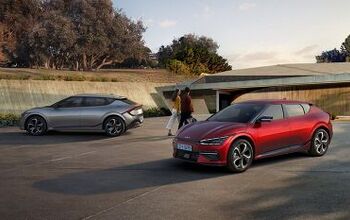Stellantis Canceling CES Tech Show Presentation, Blames UAW Strike

Stellantis has announced plans to forego the 2024 CES trade expo on the grounds that it needs to save money while the UAW strike remains in progress.
“As the costs of the ongoing UAW strikes against Stellantis continue to mount, the Company has decided to cancel its planned display and presentations at CES 2024, the world’s largest technology show, scheduled for January 2024 in Las Vegas, Nevada,” the automaker explained on Tuesday.
“Being second to none in value creation for all stakeholders – customers, employees and investors — is a key component of the Stellantis Dare Forward 2030 strategic plan. In light of the current status of negotiations in the United States, preserving business fundamentals and therefore protecting the future of the company is a top priority of Stellantis leadership.”
The company has claimed the above strategy was part of a contingency plan implemented at the start of the strike — one of its “comprehensive countermeasures to mitigate financial impacts and preserve capital” while the negotiations continue with the UAW.
The union has expanded strike efforts in recent weeks and has intentionally targeted important facilities operated by General Motors, Ford Motor Company, and Stellantis — with the latter company seeing picket lines form at the Toledo Assembly Complex responsible for the highly lucrative Jeep Gladiator and Wrangler.
Automotive executives have recently started issuing statements commenting on how strike complications will negatively impact investments and existing strategies. Bill Ford, executive chair of Ford Motor Co., literally gave a speech on the topic a few days ago. While there is undoubtedly some truth to the premise, it’s also being used as a tactic to get the public against the UAW.
Economic conditions have made the general populace relatively sympathetic to workers asking for higher wages and restored benefits. But support may begin to evaporate if automakers can convince everyday people that the strike leads to higher prices on automobiles or forces the industry into walking back pre-existing investments.
That said, the above was already happening. Average vehicle pricing has increased dramatically since 2020 and we’ve seen automakers altering their plans to cope with market realities they’ve curiously been ignoring. For example, Volkswagen Group recently opted to cut back on the production of electric cars at its German factories and canceled plans to build a new $2 billion EV factory in Wolfsburg. But it had been eliminating shifts and laying off factory workers all summer, citing “strong customer reluctance” to buy electrified products.
Some of that was down to the European Union cutting back EV subsidies. However, demand was about 30 percent shy of what the company had expected from the European market. That could simply be a matter of Volkswagen offering products people simply don’t want. Though, we’ve seen other companies struggling to make EVs work for their bottom line (e.g. Ford) and there is clearly a large subset of American car buyers that just aren’t interested in going all-electric.
While formerly a popular forum for video games, computers, and the latest tech gizmos, the Consumer Electronics Show (now just CES) has become a venue for all-electric vehicle startups and legacy manufacturers hoping to show off the latest $90,000 smartphone on wheels. There’s quite a bit of overlap with the tech and automotive industries these days. But it’s also created a schism between consumers — as the kind of person likely to attend CES probably won’t appear at the local car event unless they’re being paid.
This phenomenon is actually relatively prevalent in modern society. Multiple industries seem to have lost any connection to their consumer base (e.g. tech companies, video game publishers, media brands), ignoring sound market research to press on with products that don’t really resonate with core customers. While the automotive sector may not be the worst offender, many brands have faltered in transitioning to all-electric product portfolios and consumer complaints have been rising as more companies adopt minimalist interiors reliant on touchscreens.
Considering the clientele of the average Stellantis customer base in America is likely to prefer a larger vehicle boasting a sizable gasoline powertrain, it might not make a lot of sense to keep catering to the CES crowd. Then again, a lot of the language Stellantis is using seems to indicate a commitment to stay the course in transitioning to a tech-first “mobility company” regardless of whether or not that appeals to customers.
It could simply be talk designed to appease investors who just want to throw money behind the latest thing. Despite the large amount of attention given to the new Charger being electrified and previews of the all-electric Daytona concept, leaked images of the production model’s new body have shown a transmission tunnel and limited space allocated for battery packs. Unless there’s a separate all-electric model, the leaks were fake, or the company plans on getting extremely creative with battery packaging, it looks like gasoline-driven Chargers/Challengers might stick around for another generation.
There’s also the possibility of CES losing its appeal. While it’s still one of the largest and most relevant technology-focused trade events held annually, it’s received a reputation for fielding vaporwave products and fantastical concepts that never see production. It’s also trying to rebuild after two years of companies pulling out due to pandemic concerns. Attendance was likewise down by 70 percent in 2022. While this number rose significantly for 2023 with roughly 100,000 attendees, it was nowhere near the 170,000-person average enjoyed in 2020.
Taking into account booth rentals, staffing fees, design work, transportation costs, marketing efforts, and everything else that might go into a successful show, Stellantis was probably paying in excess of $200,000 to be a CES vendor. That’s the most conservative estimate I could put together and assumes the company was running with a relatively modest booth. It could be double or triple that sum.
But the ongoing strike is costing the industry billions of dollars, making CES a drop in the bucket. Stellantis is almost assuredly losing more money via a single day of lost production than it would have by showing up to the tech expo. Still, it’s going to need to save money where it can if no agreement can be reached between manufacturers and the UAW.
[Image: Stellantis]
Become a TTAC insider. Get the latest news, features, TTAC takes, and everything else that gets to the truth about cars first by subscribing to our newsletter.

A staunch consumer advocate tracking industry trends and regulation. Before joining TTAC, Matt spent a decade working for marketing and research firms based in NYC. Clients included several of the world’s largest automakers, global tire brands, and aftermarket part suppliers. Dissatisfied with the corporate world and resentful of having to wear suits everyday, he pivoted to writing about cars. Since then, that man has become an ardent supporter of the right-to-repair movement, been interviewed on the auto industry by national radio broadcasts, driven more rental cars than anyone ever should, participated in amateur rallying events, and received the requisite minimum training as sanctioned by the SCCA. Handy with a wrench, Matt grew up surrounded by Detroit auto workers and managed to get a pizza delivery job before he was legally eligible. He later found himself driving box trucks through Manhattan, guaranteeing future sympathy for actual truckers. He continues to conduct research pertaining to the automotive sector as an independent contractor and has since moved back to his native Michigan, closer to where the cars are born. A contrarian, Matt claims to prefer understeer — stating that front and all-wheel drive vehicles cater best to his driving style.
More by Matt Posky
Latest Car Reviews
Read moreLatest Product Reviews
Read moreRecent Comments
- Peter Buying an EV from Toyota is like buying a Bible from Donald Trump. Don’t be surprised if some very important parts are left out.
- Sheila I have a 2016 Kia Sorento that just threw a rod out of the engine case. Filed a claim for new engine and was denied…..due to a loop hole that was included in the Class Action Engine Settlement so Hyundai and Kia would be able to deny a large percentage of cars with prematurely failed engines. It’s called the KSDS Improvement Campaign. Ever hear of such a thing? It’s not even a Recall, although they know these engines are very dangerous. As unknowing consumers load themselves and kids in them everyday. Are their any new Class Action Lawsuits that anyone knows of?
- Alan Well, it will take 30 years to fix Nissan up after the Renault Alliance reduced Nissan to a paltry mess.I think Nissan will eventually improve.
- Alan This will be overpriced for what it offers.I think the "Western" auto manufacturers rip off the consumer with the Thai and Chinese made vehicles.A Chinese made Model 3 in Australia is over $70k AUD(for 1995 $45k USD) which is far more expensive than a similar Chinesium EV of equal or better quality and loaded with goodies.Chinese pickups are $20k to $30k cheaper than Thai built pickups from Ford and the Japanese brands. Who's ripping who off?
- Alan Years ago Jack Baruth held a "competition" for a piece from the B&B on the oddest pickup story (or something like that). I think 5 people were awarded the prizes.I never received mine, something about being in Australia. If TTAC is global how do you offer prizes to those overseas or are we omitted on the sly from competing?In the end I lost significant respect for Baruth.


































Comments
Join the conversation
Just have a kid in a red t-shirt and black cape (contrasting-color Fratzog logos on both) run through the show making fake engine noises.
I predict the Dodge showroom will gather cobwebs once the LX series of cars are done. I do not see the Hornet being competitive, nor is it a replacement for the LX customer to buy. I somewhat agree that badge engineering worked with Chrysler and Mitsubishi, but simply taking a Peugeot and changing the grill will not entice the LX owners to ever trade in.